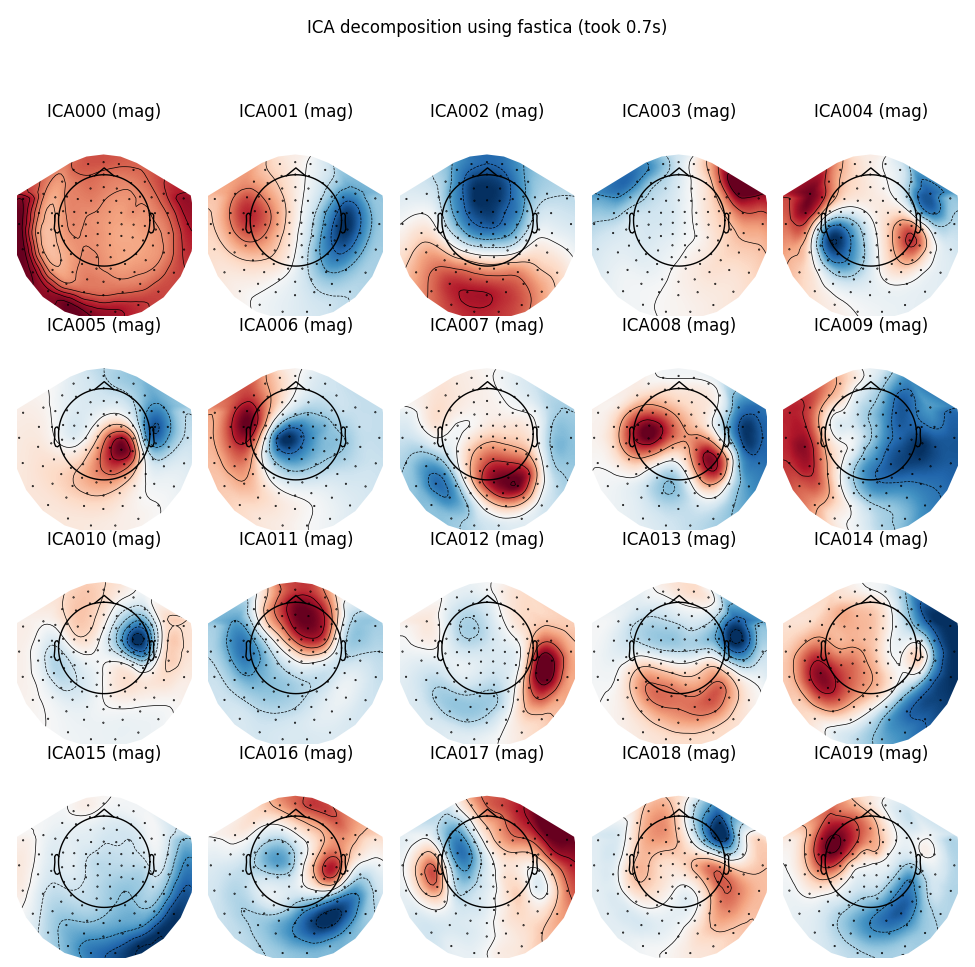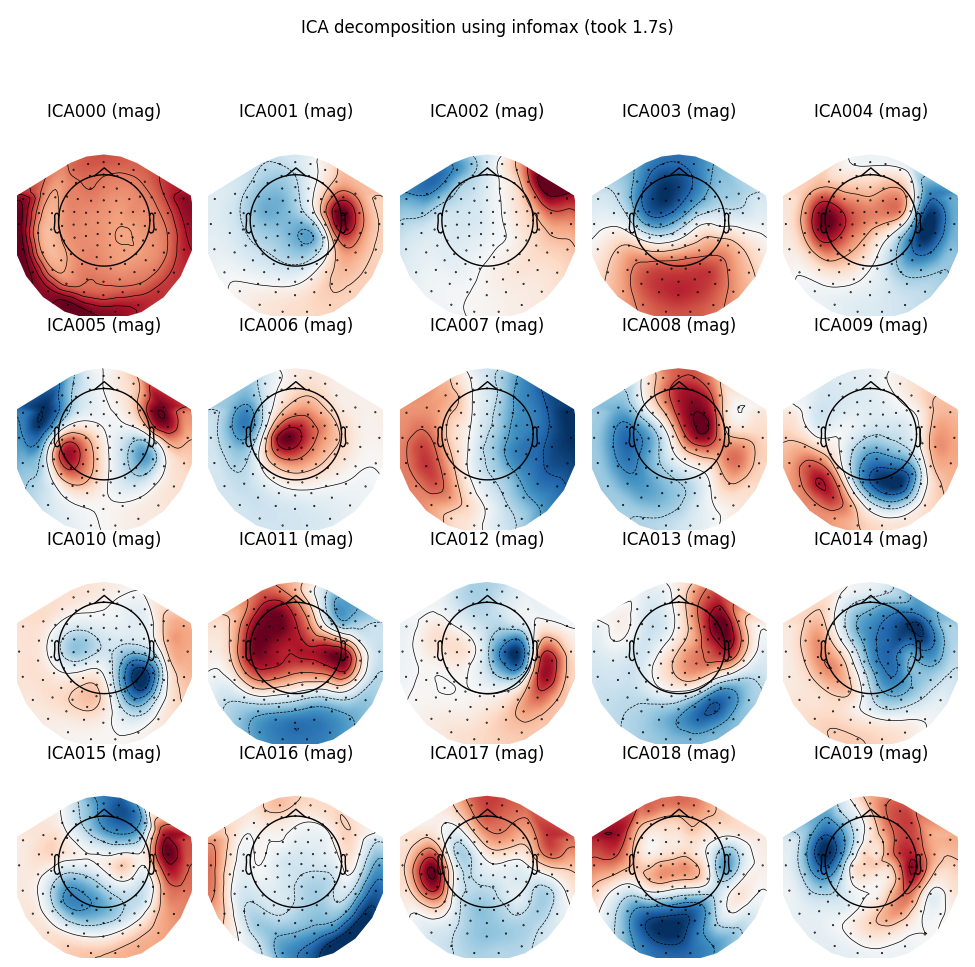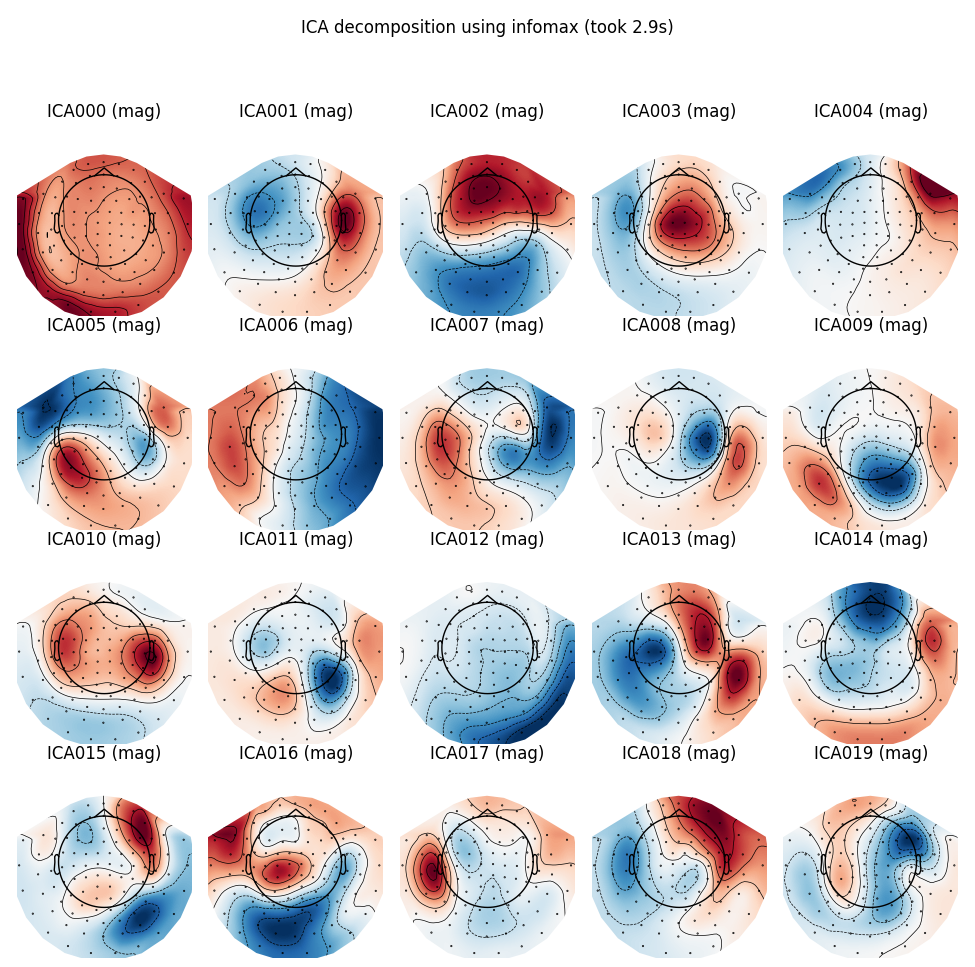Note
Click here to download the full example code
Compare the different ICA algorithms in MNE#
Different ICA algorithms are fit to raw MEG data, and the corresponding maps are displayed.
# Authors: Pierre Ablin <pierreablin@gmail.com>
#
# License: BSD-3-Clause
Read and preprocess the data. Preprocessing consists of:
MEG channel selection
1-30 Hz band-pass filter
data_path = sample.data_path()
meg_path = data_path / 'MEG' / 'sample'
raw_fname = meg_path / 'sample_audvis_filt-0-40_raw.fif'
raw = mne.io.read_raw_fif(raw_fname).crop(0, 60).pick('meg').load_data()
reject = dict(mag=5e-12, grad=4000e-13)
raw.filter(1, 30, fir_design='firwin')
Opening raw data file /home/circleci/mne_data/MNE-sample-data/MEG/sample/sample_audvis_filt-0-40_raw.fif...
Read a total of 4 projection items:
PCA-v1 (1 x 102) idle
PCA-v2 (1 x 102) idle
PCA-v3 (1 x 102) idle
Average EEG reference (1 x 60) idle
Range : 6450 ... 48149 = 42.956 ... 320.665 secs
Ready.
Removing projector <Projection | Average EEG reference, active : False, n_channels : 60>
Reading 0 ... 9009 = 0.000 ... 59.999 secs...
Filtering raw data in 1 contiguous segment
Setting up band-pass filter from 1 - 30 Hz
FIR filter parameters
---------------------
Designing a one-pass, zero-phase, non-causal bandpass filter:
- Windowed time-domain design (firwin) method
- Hamming window with 0.0194 passband ripple and 53 dB stopband attenuation
- Lower passband edge: 1.00
- Lower transition bandwidth: 1.00 Hz (-6 dB cutoff frequency: 0.50 Hz)
- Upper passband edge: 30.00 Hz
- Upper transition bandwidth: 7.50 Hz (-6 dB cutoff frequency: 33.75 Hz)
- Filter length: 497 samples (3.310 sec)
[Parallel(n_jobs=1)]: Using backend SequentialBackend with 1 concurrent workers.
[Parallel(n_jobs=1)]: Done 1 out of 1 | elapsed: 0.0s remaining: 0.0s
[Parallel(n_jobs=1)]: Done 2 out of 2 | elapsed: 0.0s remaining: 0.0s
[Parallel(n_jobs=1)]: Done 3 out of 3 | elapsed: 0.0s remaining: 0.0s
[Parallel(n_jobs=1)]: Done 4 out of 4 | elapsed: 0.0s remaining: 0.0s
[Parallel(n_jobs=1)]: Done 306 out of 306 | elapsed: 0.2s finished
Define a function that runs ICA on the raw MEG data and plots the components
def run_ica(method, fit_params=None):
ica = ICA(n_components=20, method=method, fit_params=fit_params,
max_iter='auto', random_state=0)
t0 = time()
ica.fit(raw, reject=reject)
fit_time = time() - t0
title = ('ICA decomposition using %s (took %.1fs)' % (method, fit_time))
ica.plot_components(title=title)
FastICA
run_ica('fastica')

Fitting ICA to data using 305 channels (please be patient, this may take a while)
Selecting by number: 20 components
Fitting ICA took 0.6s.
Picard
run_ica('picard')

Fitting ICA to data using 305 channels (please be patient, this may take a while)
Selecting by number: 20 components
Fitting ICA took 2.4s.
Infomax
run_ica('infomax')

Fitting ICA to data using 305 channels (please be patient, this may take a while)
Selecting by number: 20 components
Fitting ICA took 1.7s.
Extended Infomax
run_ica('infomax', fit_params=dict(extended=True))

Fitting ICA to data using 305 channels (please be patient, this may take a while)
Selecting by number: 20 components
Computing Extended Infomax ICA
Fitting ICA took 2.9s.
Total running time of the script: ( 0 minutes 28.440 seconds)
Estimated memory usage: 11 MB